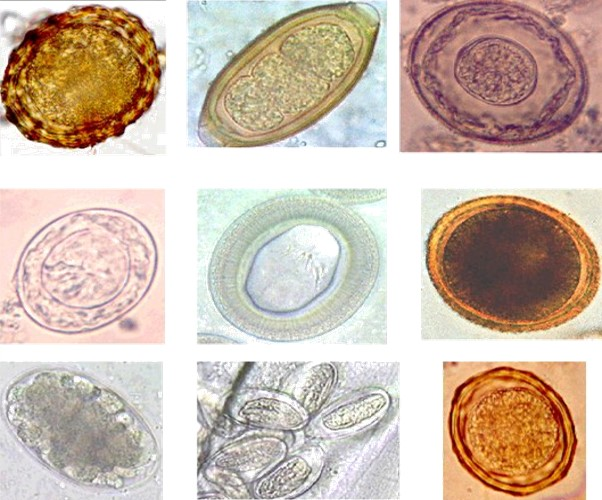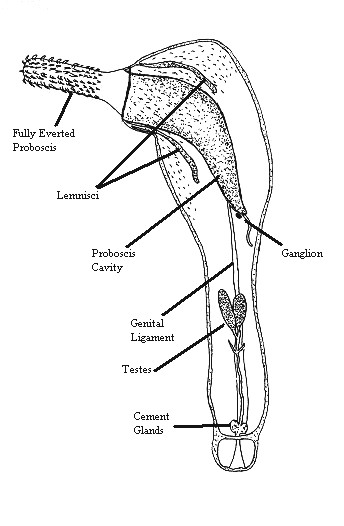|
Prosthenorchis
''Prosthenorchis'' is a genus of parasitic worms belonging to the family Oligacanthorhynchidae. ''Prosthenorchis'' have a trunk up to 50 mm long, a proboscis that is not ornate with three barbed hooks in each of 12 rows. They have complex hook roots with large manubria, and a small discoid posterior hook base. There are up to 23 festoons. Gonopore is subterminal. The primary host are primates in South America and Felidae in Africa with cockroaches and beetles as intermediate hosts. Taxonomy Phylogenetic analysis had been performed on ''P.elegans''. Description ''Prosthenorchis'' consists of a proboscis covered in hooks and a trunk. Species THere are five species in the genus ''Prosthenorchis''. *''Prosthenorchis cerdocyonis'' Gomes, Ana Paula & Olifiers, Natalie & Souza, Joyce & Barbosa, Helene & D'Andrea, Paulo & Maldonado, Arnaldo. (2014). A New Acanthocephalan Species (Archiacanthocephala: Oligacanthorhynchidae) from the Crab-Eating Fox ( Cerdocyon thous ) in the Brazilia ... [...More Info...] [...Related Items...] OR: [Wikipedia] [Google] [Baidu] |
Oligacanthorhynchidae
Oligacanthorhynchida is an order containing a single parasitic worm family, Oligacanthorhynchidae, that attach themselves to the intestinal wall of terrestrial vertebrates. Taxonomy and description Species ''Oligacanthorhynchida'' contains twelve genera and numerous species. Cucullanorhynchus The genus ''Cucullanorhynchus'' Amin, Ha and Heckmann, 2008 is named for the anterior hood. It was described in 2008 based on samples collected from the intestines of mammals between 1998 and 2004 in Vietnam. *''Cucullanorhynchus constrictruncatus'' Amin, Ha and Heckmann, 2008 ''C. constrictruncatus'' is the only species in the genus ''Cucullanorhynchus''. It has been found in the intestine of the leopard (''Panthera pardus'') in Vietnam. The trunk has an anterior hood in both sexes and a posterior constriction in females. The species name derives from this constriction near the posterior end of females. Heptamegacanthus The genus ''Heptamegacanthus'' Spencer-Jones, 1990 contains 1 sp ... [...More Info...] [...Related Items...] OR: [Wikipedia] [Google] [Baidu] |
Parasitic Worms
Parasitic worms, also known as helminths, are large Parasitism#Basic concepts, macroparasites; adults can generally be seen with the naked eye. Many are intestinal worms that are soil-transmitted helminth, soil-transmitted and intestinal parasite infection, infect the gastrointestinal tract. Other parasitic worms such as schistosomes reside in blood vessels. Some parasitic worms, including leeches and monogeneans, are ectoparasites thus, they are not classified as helminths, which are Parasitism#Basic concepts, endoparasites. Parasitic worms live in and feed in living host (biology), hosts. They receive nourishment and protection while disrupting their hosts' ability to absorb nutrients. This can cause weakness and disease in the host, and poses a global health and economic problem. Parasitic worms cannot reproduce entirely within their host's body; they have a life cycle that includes some stages that need to take place outside of the host. Helminths are able to survive in the ... [...More Info...] [...Related Items...] OR: [Wikipedia] [Google] [Baidu] |
Beetles
Beetles are insects that form the Taxonomic rank, order Coleoptera (), in the superorder Endopterygota. Their front pair of wings are hardened into wing-cases, Elytron, elytra, distinguishing them from most other insects. The Coleoptera, with about 400,000 described species, is the largest of all orders, constituting almost 40% of described insects and 25% of all known animal life-forms; new species are discovered frequently, with estimates suggesting that there are between 0.9 and 2.1 million total species. Found in almost every habitat except the sea and the polar regions, they interact with their ecosystems in several ways: beetles often feed on plants and fungus, fungi, break down animal and plant debris, and eat other invertebrates. Some species are serious agricultural pests, such as the Colorado potato beetle, while others such as Coccinellidae (ladybirds or ladybugs) eat aphids, scale insects, thrips, and other plant-sucking insects that damage crops. Beetles typicall ... [...More Info...] [...Related Items...] OR: [Wikipedia] [Google] [Baidu] |
Binomial Nomenclature
In taxonomy, binomial nomenclature ("two-term naming system"), also called nomenclature ("two-name naming system") or binary nomenclature, is a formal system of naming species of living things by giving each a name composed of two parts, both of which use Latin grammatical forms, although they can be based on words from other languages. Such a name is called a binomial name (which may be shortened to just "binomial"), a binomen, name or a scientific name; more informally it is also historically called a Latin name. The first part of the name – the '' generic name'' – identifies the genus to which the species belongs, whereas the second part – the specific name or specific epithet – distinguishes the species within the genus. For example, modern humans belong to the genus '' Homo'' and within this genus to the species '' Homo sapiens''. '' Tyrannosaurus rex'' is likely the most widely known binomial. The ''formal'' introduction of this system of naming species is ... [...More Info...] [...Related Items...] OR: [Wikipedia] [Google] [Baidu] |
Crab-Eating Fox
The crab-eating fox (''Cerdocyon thous''), also known as the forest fox, wood fox, bushdog (not to be confused with the bush dog) or maikong, is an extant species of medium-sized canid endemic to the central part of South America since at least the Pleistocene epoch. Like South American foxes, which are in the genus ''Lycalopex'', it is not closely related to true foxes. ''Cerdocyon'' comes from the Greek words ''kerdo'' (meaning fox) and ''kyon'' (dog) referring to the dog- and fox-like characteristics of this animal. Taxonomy and evolution The crab-eating fox was originally described as ''Canis thous'' by Linnaeus (1766), and first placed in its current genus ''Cerdocyon'' by Hamilton-Smith in 1839. Cerdocyonina is a tribe which appeared around 6.0 million years ago (Mya) in North America as '' Ferrucyon avius'' becoming extinct by around 1.4–1.3 Mya. living about . This genus has persisted in South America from an undetermined time, possibly around 3.1 Mya, and conti ... [...More Info...] [...Related Items...] OR: [Wikipedia] [Google] [Baidu] |
Acanthocephala LifeCycle Lg
Acanthocephala ( Greek , ', thorn + , ', head) is a phylum of parasitic worms known as acanthocephalans, thorny-headed worms, or spiny-headed worms, characterized by the presence of an eversible proboscis, armed with spines, which it uses to pierce and hold the gut wall of its host. Acanthocephalans have complex life cycles, involving at least two hosts, which may include invertebrates, fish, amphibians, birds, and mammals. About 1420 species have been described. The Acanthocephala were thought to be a discrete phylum. Recent genome analysis has shown that they are descended from, and should be considered as, highly modified rotifers. This unified taxon is known as Syndermata. History The earliest recognisable description of Acanthocephala – a worm with a proboscis armed with hooks – was made by Italian author Francesco Redi (1684).Crompton 1985, p. 27 In 1771, Joseph Koelreuter proposed the name Acanthocephala. Philipp Ludwig Statius Müller independently called ... [...More Info...] [...Related Items...] OR: [Wikipedia] [Google] [Baidu] |
Host (biology)
In biology and medicine, a host is a larger organism that harbours a smaller organism; whether a parasitic, a mutualistic, or a commensalist ''guest'' (symbiont). The guest is typically provided with nourishment and shelter. Examples include animals playing host to parasitic worms (e.g. nematodes), cells harbouring pathogenic (disease-causing) viruses, a bean plant hosting mutualistic (helpful) nitrogen-fixing bacteria. More specifically in botany, a host plant supplies food resources to micropredators, which have an evolutionarily stable relationship with their hosts similar to ectoparasitism. The host range is the collection of hosts that an organism can use as a partner. Symbiosis Symbiosis spans a wide variety of possible relationships between organisms, differing in their permanence and their effects on the two parties. If one of the partners in an association is much larger than the other, it is generally known as the host. In parasitism, the parasite benefits ... [...More Info...] [...Related Items...] OR: [Wikipedia] [Google] [Baidu] |
Molt
In biology, moulting (British English), or molting (American English), also known as sloughing, shedding, or in many invertebrates, ecdysis, is the manner in which an animal routinely casts off a part of its body (often, but not always, an outer layer or covering), either at specific times of the year, or at specific points in its life cycle. In medieval times it was also known as "mewing" (from the French verb "muer", to moult), a term that lives on in the name of Britain's Royal Mews where the King's hawks used to be kept during moulting time before becoming horse stables after Tudor times. Moulting can involve shedding the epidermis (skin), pelage ( hair, feathers, fur, wool), or other external layer. In some groups, other body parts may be shed, for example, the entire exoskeleton in arthropods, including the wings in some insects. Examples In birds In birds, moulting is the periodic replacement of feathers by shedding old feathers while producing new ones. Feat ... [...More Info...] [...Related Items...] OR: [Wikipedia] [Google] [Baidu] |
Mesenteron
The midgut is the portion of the embryo from which most of the intestines develop. After it bends around the superior mesenteric artery, it is called the "midgut loop". It comprises the portion of the alimentary canal from the end of the foregut at the opening of the bile duct to the hindgut, about two-thirds of the way through the transverse colon. In the embryo During development, the human midgut undergoes a rapid phase of growth in which the loop of midgut herniates outside of the abdominal cavity of the fetus and protrudes into the umbilical cord. This herniation is physiological (occurs normally). Later in development, the fetus's body catches up in size relative to the midgut and creates adequate room in the abdominal cavity for the entirety of the midgut to reside. The midgut loops slip back out of the umbilical cord and the physiological hernia ceases to exist. This change coincides with the termination of the yolk sac and the counterclockwise rotation of the two limb ... [...More Info...] [...Related Items...] OR: [Wikipedia] [Google] [Baidu] |
Larva
A larva (; plural larvae ) is a distinct juvenile form many animals undergo before metamorphosis into adults. Animals with indirect development such as insects, amphibians, or cnidarians typically have a larval phase of their life cycle. The larva's appearance is generally very different from the adult form (''e.g.'' caterpillars and butterflies) including different unique structures and organs that do not occur in the adult form. Their diet may also be considerably different. Larvae are frequently adapted to different environments than adults. For example, some larvae such as tadpoles live almost exclusively in aquatic environments, but can live outside water as adult frogs. By living in a distinct environment, larvae may be given shelter from predators and reduce competition for resources with the adult population. Animals in the larval stage will consume food to fuel their transition into the adult form. In some organisms like polychaetes and barnacles, adults are im ... [...More Info...] [...Related Items...] OR: [Wikipedia] [Google] [Baidu] |
Feces
Feces ( or faeces), known colloquially and in slang as poo and poop, are the solid or semi-solid remains of food that was not digested in the small intestine, and has been broken down by bacteria in the large intestine. Feces contain a relatively small amount of metabolic waste products such as bacterially altered bilirubin, and dead epithelial cells from the lining of the gut. Feces are discharged through the anus or cloaca during defecation. Feces can be used as fertilizer or soil conditioner in agriculture. They can also be burned as fuel or dried and used for construction. Some medicinal uses have been found. In the case of human feces, fecal transplants or fecal bacteriotherapy are in use. Urine and feces together are called excreta. Skatole is the principal compound responsible for the unpleasant smell of feces. Characteristics The distinctive odor of feces is due to skatole, and thiols (sulfur-containing compounds), as well as amines and carboxylic aci ... [...More Info...] [...Related Items...] OR: [Wikipedia] [Google] [Baidu] |
Tayra
The tayra (''Eira barbara'') is an omnivorous animal from the weasel family, native to the Americas. It is the only species in the genus ''Eira''. Tayras are also known as the ''tolomuco'' or ''perico ligero'' in Central America, ''motete'' in Honduras, ''irara'' in Brazil, ''san hol'' or ''viejo de monte'' in the Yucatan Peninsula, and high-woods dog (or historically ''chien bois'') in Trinidad. The genus name ''Eira'' is derived from the indigenous name of the animal in Bolivia and Peru, while ''barbara'' means "strange" or "foreign". Description Tayras are long, slender animals with an appearance similar to that of weasels and martens. They range from in length, not including a 37- to 46-cm-long (15 to 18 in) bushy tail, and weigh . Males are larger, and slightly more muscular, than females. They have short, dark brown to black fur which is relatively uniform across the body, limbs, and tail, except for a yellow or orange spot on the chest. The fur on the head and neck ... [...More Info...] [...Related Items...] OR: [Wikipedia] [Google] [Baidu] |





.jpg)



